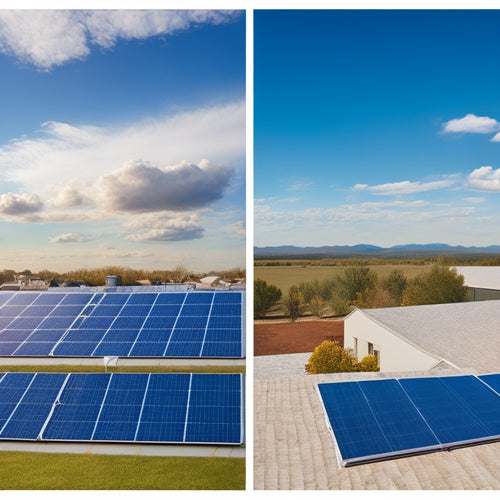Optimizing Energy Storage Systems With 5 Essential Tools
Share
You can optimize your energy storage system's performance, efficiency, and reliability by leveraging five essential tools that provide critical insights, predictive maintenance, and real-time analytics, ultimately resulting in improved system health and reduced downtime. These tools include monitoring system performance metrics, real-time energy storage analytics, predictive maintenance and alerts, energy efficiency optimization tools, and data-driven system insights generation. By harnessing these tools, you'll be able to identify areas of improvement, streamline operations, and boost overall system efficiency. As you explore these tools in greater detail, you'll uncover even more opportunities to fine-tune your energy storage system.
Key Takeaways
• Evaluate energy storage system performance using key metrics like efficiency, reliability, and health to identify areas for optimization.
• Utilize real-time analytics and machine learning algorithms to access deeper insights and identify opportunities for improvement.
• Implement predictive maintenance to detect potential issues, reduce downtime, and increase efficiency with timely alerts and condition monitoring.
• Empower energy storage systems with energy efficiency tools that dynamically adjust parameters for peak performance and optimal battery life.
• Generate data-driven insights using advanced analytics and visualization tools to uncover hidden efficiencies and respond promptly to changes in system performance.
Monitoring System Performance Metrics
When evaluating the performance of an energy storage system, you need to track key metrics that provide insights into its efficiency, reliability, and overall health. These metrics serve as system benchmarks, enabling you to assess the system's performance against predetermined standards.
By monitoring these metrics, you can identify areas of improvement, optimize system operations, and guarantee that your energy storage system meets the desired performance thresholds.
To set meaningful benchmarks, you'll need to establish clear performance thresholds. These thresholds will vary depending on your specific system requirements and application.
For instance, you may set a threshold for round-trip efficiency, ensuring that your system can deliver a minimum percentage of the stored energy back to the grid. By setting these thresholds, you can trigger alerts or notifications when the system's performance deviates from the expected norms.
This proactive approach enables you to address potential issues before they impact the system's overall health and efficiency. By tracking these key metrics and setting performance thresholds, you can ensure your energy storage system operates at peak levels, providing reliable and efficient energy storage and release.
Real-time Energy Storage Analytics
You can access deeper insights into your energy storage system's performance by leveraging real-time analytics, which provide a granular view of your system's operations and enable data-driven decisions. With real-time analytics, you can identify areas of improvement, optimize system performance, and reduce operational costs.
To get the most out of real-time analytics, you'll want to:
-
Integrate analytics platforms with your energy storage system to collect and analyze data in real-time.
-
Utilize data visualization tools to present complex data in an easy-to-understand format, enabling swift identification of trends and patterns.
-
Set up customizable dashboards to track key performance indicators (KPIs) and receive alerts when thresholds are exceeded.
- Leverage machine learning algorithms to uncover hidden insights and identify opportunities for optimization.
Predictive Maintenance and Alerts
By implementing predictive maintenance and alerts, your energy storage system can detect potential issues before they occur, reducing downtime and increasing overall efficiency. This proactive approach allows you to identify and address potential faults before they become major problems, minimizing the risk of unexpected failures and reducing maintenance costs.
Through advanced condition monitoring, you'll be able to track the health of your energy storage system in real-time, detecting subtle changes in performance that could indicate a potential issue. By leveraging machine learning algorithms and advanced analytics, your system can identify patterns and anomalies that may indicate a fault, allowing you to take corrective action before it's too late.
With fault detection capabilities, you'll receive timely alerts and notifications, enabling you to respond quickly and effectively to potential problems. By staying one step ahead of potential issues, you can make sure your energy storage system operates at peak performance, reducing downtime and increasing overall efficiency.
Energy Efficiency Optimization Tools
Energy efficiency optimization tools empower your energy storage system to achieve peak performance, dynamically adjusting parameters to minimize energy losses and maximize overall efficiency. By leveraging these tools, you can guarantee your system operates at its best, reducing waste and maximizing returns.
Here are four essential energy efficiency optimization tools to integrate into your system:
-
Advanced Battery Management Systems: Monitor and control battery performance, ensuring peak charging and discharging cycles to prolong battery life and reduce energy losses.
-
Grid Modernization Analytics: Utilize real-time data to optimize grid operations, predicting and adapting to changes in energy demand and supply.
-
Battery Swapping Optimization: Streamline the battery swapping process, minimizing downtime and reducing energy waste during replacement and maintenance operations.
- Energy Loss Detection Algorithms: Identify and address energy losses in real-time, pinpointing areas of inefficiency and providing actionable insights for improvement.
Data-Driven System Insights Generation
To optimize energy storage system performance, generating data-driven system insights is essential for identifying areas of improvement and uncovering hidden efficiencies. By leveraging advanced analytics and machine learning algorithms, you can uncover patterns and trends in your energy storage system's data that would be impossible to detect manually. This enables you to pinpoint areas where energy is being wasted, identify opportunities for optimization, and make data-driven decisions to enhance overall system performance.
Advanced visualization tools can help you make sense of the vast amounts of data generated by your energy storage system. By creating interactive, intuitive dashboards, you can quickly identify trends, anomalies, and areas for improvement. This enables you to respond promptly to changes in system performance, make adjustments in real-time, and ensure that your energy storage system is operating at peak efficiency.
Frequently Asked Questions
What Are the Key Factors Affecting Energy Storage System Costs?
When you explore energy storage system costs, you'll discover that supply chain dynamics, research grants, and technology advancements are key factors that greatly influence expenses, making it essential to take these variables into account in your cost-benefit analysis.
Can Energy Storage Systems Be Used for Grid Stabilization?
You can leverage energy storage systems to enhance grid resilience by providing frequency regulation, ensuring a stable grid operation and mitigating power fluctuations, thereby maintaining a reliable energy supply.
How Do Energy Storage Systems Impact Renewable Energy Adoption?
"As you ponder, 'What's the point of harnessing renewable energy if we can't store it?' you'll find that energy storage systems amplify renewable synergy, enabling energy democracy by bridging supply and demand gaps, and fostering a sense of community through shared, sustainable power."
Are Energy Storage Systems Suitable for Residential Applications?
You're wondering if energy storage systems are suitable for residential applications? Absolutely! With home automation and energy efficiency in mind, you can seamlessly integrate energy storage systems into your home, optimizing your energy usage and reducing your carbon footprint.
Can Energy Storage Systems Be Integrated With Existing Infrastructure?
Can you imagine seamlessly merging new energy storage systems with existing infrastructure? You'll need to take into account an infrastructure upgrade, ensuring system compatibility to guarantee a harmonious marriage between old and new, paving the way for a seamless integration.
Related Posts
-

Safety First: Why Seniors Need Advanced Vehicle Features
As you get behind the wheel, you're likely unaware that seniors are 16% more likely to be involved in a fatal car cra...
-

10 Tips for Cleaner City Air With Scooters
By adopting a few simple habits, you can make a significant impact on reducing city air pollution with your scooter. ...
-

Tracking Solar Panels Vs Fixed Panels Cost Savings
When considering solar panel options, you'll want to weigh the cost savings of tracking solar panels versus fixed pan...


